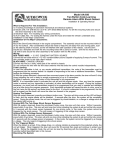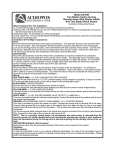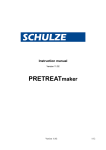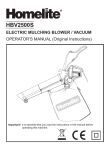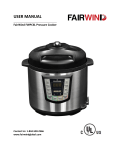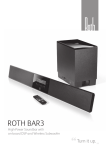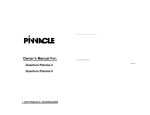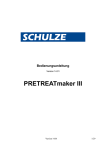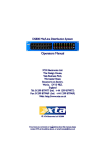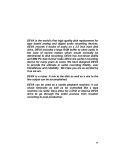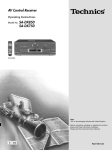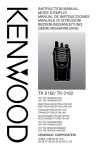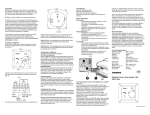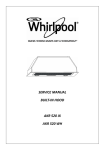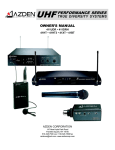Download User Manual
Transcript
Operation Manual ARGO 300 240 Channel Mobile AM / FM Transceiver General Description This Model is a combination transmitter-receiver designed primarily for mobile use. It employs the very latest technology to provide 240channels of operation by means of digital frequency synthesis with PLL (phase-locked-loop) circuitry. The use of PLL assures a precise on-frequency operation on every channel in both transmit and receive mode. This model also includes many other features which will provide greater operating convenience and assure optimum communications under a wide range of conditions. Operable on 240 channels divided into six groups of 40 channels. Full noise reduction features - ANL and noise blanker. 2 modes of operation - AM, FM - selectable with switch. RF power output switchable in 2 ways for required communication range. External speaker jack for an extra sound source. Electrically floating cliassis for negative ground operation without switching. A high-sensitivity dynamic microphone equipment. CAUNTION FOR REPLACEMENT OF THE FUSE IN DC POWER CABLE, PLEASE BE SURE TO USE 2A FUSE. 2 Specifications General * Channel : 240 channel (40CH X 6) * Frequency composition : Digital phase locked loop synthesizer * Modulation mode : AM/FM * Frequency range : Band A 26.065 ~ 26.505 Mhz 〃 B 26.515 ~ 26.955 〃 〃 C 26.965 ~ 27.405 〃 〃 D 27.415 ~ 27.855 〃 〃 E 27.865 ~ 28.305 〃 〃 F 28.315 ~ 28.755 〃 * Channel spacing : 10 kHz * Antenna impeadance : 50 Ohm * Power supply source : 13.8 Volt DC(Only negative ground) * Operating temperature : -10℃ ~ +50℃ * Dimensions : 160(W) X 55(H) X 210(D)mm * Weight : 1,100 g Receiver * Sensitivity : AM FM 1 uV, S/N 10dB 1 uV, S/N 20dB * Selectivity : 60 dB * Squelch range : 0.2 uV ~ 500 uV * IF : 1 st 10.695 MHz ,2nd 455 KHZ * Audio output power : 2 watts at 8 Ohm * Sprious response : 50 dB Transmitter * RF output power : AM/FM High 7 watt Low 4 watt * Frequency stability : 0.005% * Modulation capability : AM 100%, FM * Sprious emission : 60 dB 3 2.5 Khz deviation max. CONTROL LOCATIONS Fig. 1 Fig. 2 1. Channel Selector 15. Microphone Socket 2. LED Channel Indicator 16. Power Socket 3. Signal Strength/Powe 17. External Speaker Socket Output Indicators 18. Coaxial Acrial Socket 4. Band Selector 5. On / Off-Volume Control 6. Receive Indicator 7. Squelch Control 8. Transmit Indicator 9. RF Gain Control 10. AM Indicator 11. FM Indicator 12. R F power switch 13. Model selector Switch 14. ANL + NB /Off Switch FRONT VIEW 4 5 3 6 7 8 2 9 10 11 12 13 REAR VIEW 18 1 Fig. 1 14 17 16 15 Fig. 2 4 Operating Controls and Features 1. Channel selector A 40-detent rotary, switch to select any of 240 channels in conjunction with the Band Selector switch. Window above this switch indicates the channel selected using an LED (Light-emitting-diode)digital readout. 2.Channel indicator A digital LED display to show channel selected. Turned off when operating PA. 3.S/RF indicator When an incoming signal is received the RX indicator will illuminate. and the signal indicator will illuminate to monitor the relative strength of the signal. The strength of the incoming signal will depend on the performance of the transmitter and aerial, your distance from it and the nature of the surrounding area, not on your set’ s ability to receive the transmitted signal. Power output is registered by the LED indicators. 4.Band Selector Selects a group of 40 channels in six positions - A, B, C, D, E or F (240 in all). 5.Off/Volume Control Varies the sound output form the speaker. Also incorporates an on-off switch at the extremely counterclockwise position. 6.RX indicator Lights up when receiving. 7.Squelch Control Used to eliminate any annoying background noise when no signals are present. The degree of sensitivity to incoming signals is adjustable. When the Squelch control is rotated to the fully clockwise position, it provides maximum squelch, in the fully counterclockwise position, it provides minimum squelch. 8.TX indicator Lights up when transmitting. 9.RF Gain Control Selects RF Gain (receiver sensitivity) of the transceiver in variations. MAX. In this position, the receiver section provides maximum sensitivity so that it can pick up even weak signals. Normally this switch should be placed in this position. MIN. In this position, the receiver sensitivity is minimum, and the receiver will pick up only the strong signals. May be used when receiving strong (close) signals which are causing overload in receiving sound. 10. AM indicator Lights up when operating AM 11. FM indicator Lights up when operating FM 5 12. Power Selecto r Enables you to select the RF power output of the transceiver in 2 ways. High . In this position the transceiver produces full rated RF power for maximum communication range. LOW. In this position, the minimum R F power output is obtained, may be used for short range communication. 13. Mode switch Selects the mode of reception and transmission -AM (amplitude modulation). FM (frequency modulation) 14.ANL + NB/Off Switch In the upper position the ANL is activated lower position the ANL is off and in together with the NB(noise blanker). 15.Microphone jack Accepts plug form the microphone supplied. The jack has a locating key inside and allows the plug inserted in only one way. Do not force the plug but align key way properly onto the jack. 16. 13.8 V DC jack 13.8 V DC power for the transceiver supplied through this socket (using DC power cable supplied). 17.Exermal Speaker jack Used to connect an external speaker (8 Ohm 4 W) as an extra sound source. Insertion of the plug from a speaker will silence the internal speaker automatically. 18. Antenna Accepts a PL 259 type coaxial connector from the antenna lead-in cable. Installation Safety and convenience are the primary factors in deciding exactly where to locate your transceiver. The transceiver is designed for ease in control accessibility .Be sure that the unit is located so that it does not interfere with the driver or impair access to any controls. Connecting cables must be routed and secured in such a controls. Interference from either the operation of the brake, accelerator or other controls. Interference from either the unit or connecting cables may contribute to the loss of control of the vehicle. The transceiver is designed for use with either negative or positive ground electrical systems. 6 MOUNTING BRACKET MOUNT SCREW 2 COAXIAL PLUG WIREPLUG FROM EXT SP TAPPING SCREW 3 WASHER 3 2A FUSE HOLDER 12V Battery Positive (+) Terminal PLUS (+) WIRE DC PLUG MINUS(—)WIRE 12V Battery Negative (—) Terminal MICROPHONE BRACKET TAPPING SCREW 2 WASHER 2 Mechanical Mounting Step 1: Use the mounting bracket as a template for marking the location of screwholes under your dash. Use an awl, nail or other pointed object to mark the metal. Step 2: Drill a 3.2mm hole for each screwhole in the mounting bracket. Attach the bracket to the dash with the machine screws provided. Extreme caution should be exercised when drilling into dash to avoid damage to underdash electronic ignition, cruise control, instrument and / or accessory wiring. 7 Step 1: With negative ground system, connect the red wire (one with in-line fuse holder) to either the (a) fuse block, (b) cigarette lighter, or (C ) directly to the positive post on the battery . Usually, the fuse block is the most convenient connecting point. It is also possible to connect to the Accessory terminal on the fuse block or ignition switch, so that your CB unit automatically goes off, preventing accidental battery drainage. Then tightly connect the black wire directly to the vehicle’ s metal frame. Step 2: With positive ground system, reverse the wires, connecting the red/ fuseholder wire to the frame, the black wire to your DC power source. A light or meter can be a good aid in locating a suitable power source and ground. In either case, a good, direct metal-to-metal ground is essential for optimum performance. Connect your antenna system to the antenna connector, If you are using an external speaker or a PA speaker, connect it to the appropriate jack one unit rear panel. CB Antennas Note: The licence requires that equipment which have provision for the connection of an external antenna shall not be connected to other than a single element rod or wire antenna not exceeding 1.5m in overall length. For best reception and transmission, your radio should use an antenna especially designed for a frequency of 27.7 MHz. Antennas are purchased separately and supplied with assembly and installation instructions, mounting hardware, and a coaxial antenna cable fitted with a fully assembled standard connector (type PL-259) for quick connection to your transceiver. CB antennas are available in many sizes and styles. Base loaded quarter-wave antennas are most popular because they require less space than full quarter-wave types and are easily installed. These antenna types physically shorter but electrically equivalent to full quarte rwave whip antennas. We advise the use of base loaded whips of less than 1.5 meters. The antenna’ s mounted location on the vehicle affects the operation of the radio. Transmission and reception characteristics vary for different antenna locations, Three of the most popular antenna mountings are shown on next page. Roof mount - The antenna mounted on roof represents a transmission/reception range closest o ideal. Front cowl mount - The radiation pattern is slightly greater in the direction of the rear bumper opposite the side on which the antenna is mounted. Provides case in antenna mounting. Rear deck mount - The radiation pattern is strongest in the direction of the front bumper opposite the side on which the antenna is mounted. 8 Roof Mount Front Cowl Mount Rear Deck Mount General rules for best mobile antenna performanc e 1. Mount antenna on vehicle as high as possible. 2. The higher percentage of the antenna length mounted above rooftop, the better performance. 3.Centre antenna in middle of selected location (i.e., boot, gutter or roof ). 4.Install an antenna cable line away from noise sources (ignition system, gauges ,etc.). 5.Be sure to mount antenna with a good mental-to-metal ground. 6. Prevent antenna cable damage. About SWR Antenna performance may be peaked by slightly adjusting its length(1/8〃to 1 /4〃) using an SWR (standing wave ratio) meter. This meter is purchased separately or the SWR can be checked professionally. Most antennas are factory-tuned,but this adjustment may improve antenna efficiency. An SWR reading below 3:1 is desired, as this indicates that over 75% of the transmit power is broadcast power is broadcast into the air. The rest is‘reflected ’back into your transceiver and dissipated as harmless heat. See chart below. An SWR of 2:1 or below is good, 2.5 or even 3 is usually not user noticeable or significant. SWR Reading 1 :1 1.3 :1 1.5 :1 1.7 :1 2 :1 3 :1 4 :1 5 :1 6 :1 10 :1 Output 9 Power Transmitted 100% 98.3% 96.0% 93.3% 89.0% 75.0% 64.0% 58.0% 49.0% 33.0% Channel Selection The transceiver is capable of operation on 240 channels which are divided into 6 groups of 40 channels - A,B,C,D,E and F. These groups are selected with the Band Selector switch as the following. Band switch Position A B C D E F Frequency 26.065 to 26.515 to 26.965 to 27.415 to 27.865 to 28.315 to Range 26.505 26.955 27.405 27.855 28.305 28.755 MHz MHz MHz MHz MHz MHz After the band to which the channel you desire to operate belongs is selected, rotate the channel selector to find the channel. Rotating the channel selector clock-wise or counterclockwise by 1 detent will tune the transceiver 10 kHz upscale or downscale. i to operate on 27.405 MHz first set the Band selector switch to `c`, C If you desire then turn the channel selector to the position at which the channel readout shows ‘40 ’ . Operation (1) Turn the Volume control clockwise to apply power to the transceiver. The LED display should be illuminated. (2) Rotate the Squelch control counterclockwise fully. (3) Select the mode of reception AM, FM. (4) Set the RF Gain control maximum position. (5) Select the channel desired. (6) To transmit, depress the transmit switch on microphone, to receive, release the switch. RF Gain Control Ajustment Normally, this control should be set to Max. Position to provide maximum receiver sensitivity for long range reception. However, When communicating with a nearby station, you may find that the strong signal from this station may cause overloading of your receiver. In such a case. You can sue this control to reduce the receiver Sensitivity and thus prevent any overloading and distortion that may occur as a result of the extremely strong incoming signals. First set the switch to center and if this position will not provide a sufficient reduction of overloading condition, set to minimum Position. 10 Channel 1 2 3 4 5 6 7 8 9 10 11 12. 13. 14. 15. 16. 17. 18. 19. 20. 21. 22. 23. 24. 25 26. 27. 28. 29. 30. 31. 32. 33. 34. 35. 36. 37. 38. 39 40 Frequency 26.515 26.525 26.535 26.555 26.565 26.575 26.585 26.605 26.615 26.625 26.635 26.655 26.665 26.675 26.685 26.705 26.715 26.725 26.735 26.755 26.765 26.775 26.805 26.785 26.795 26.815 26.825 26.835 26.845 26.855 26.865 26.875 26.885 26.895 26.905 26.915 26.925 26.935 26.945 26.955 MHz B-Band Frequency/Channel Chart A-Band MHz Channel Frequency 26.065 1 26.075 2 26.085 3 26.105 4 26.115 5 26.125 6 26.135 7 26.155 8 26.165 9 10 26.175 11 26.185 12. 26.205 13. 26.215 14. 26.225 15. 26.235 16. 26.255 17. 26.265 18. 26.275 19. 26.285 20. 26.305 21. 26.315 22. 26.325 23. 26.355 24. 26.335 25 26.345 26. 26.365 27. 26.375 28. 26.385 29. 26.395 30. 26.405 31. 26.415 32. 26.425 33. 26.435 34. 26.445 35. 26.455 36. 26.465 37. 26.475 38. 26.485 39 26.795 40 26.505 Frequency 26.965 26.975 27.985 27.005 27.015 27.025 27.035 27.055 27.065 27.075 27.085 27.105 27.115 27.125 27.135 27.155 27.165 27.175 27.185 27.205 27.215 27.225 27.255 27.235 27.245 27.265 27.275 27.285 27.295 27.305 27.315 27.325 27.335 27.345 27.355 27.365 27.475 27.385 27.395 27.405 MHz C-Band Channel 1 2 3 4 5 6 7 8 9 10 11 12. 13. 14. 15. 16. 17. 18. 19. 20. 21. 22. 23. 24. 25 26. 27. 28. 29. 30. 31. 32. 33. 34. 35. 36. 37. 38. 39 40 Frequency 27.415 27.425 27.435 27.455 27.465 27.475 27.485 27.505 27.515 27.525 27.535 27.555 27.565 27.575 27.585 27.605 27.615 27.625 27.635 27.655 27.665 27.675 27.705 27.685 27.695 27.715 27.725 27.735 27.745 27.755 27.765 27.775 27.785 27.795 27.805 27.815 27.825 27.835 27.845 27.855 MHz D-Band Channel 1 2 3 4 5 6 7 8 9 10 11 12. 13. 14. 15. 16. 17. 18. 19. 20. 21. 22. 23. 24. 25 26. 27. 28. 29. 30. 31. 32. 33. 34. 35. 36. 37. 38. 39 40 E-Band MHz Channel Frequency 27.865 1 27.875 2 27.885 3 27.905 4 27.915 5 27.925 6 27.935 7 27.955 8 27.965 9 10 27.975 11 27.985 12. 28.005 13. 28.015 14. 28.025 15. 28.035 16. 28.055 17. 28.065 18. 28.075 19. 28.085 20. 28.105 21. 28.115 22. 28.125 23. 28.155 24. 28.135 25 28.145 26. 28.165 27. 28.175 28. 28.185 29. 28.195 30. 28.205 31. 28.215 32. 28.225 33. 28.235 34. 28.245 35. 28.255 36. 28.265 37. 28.275 38. 28.285 39 28.295 40 28.305 F-Band MHz Channel Frequency 28.315 1 28.325 2 28.335 3 28.355 4 28.365 5 28.375 6 28.385 7 28.405 8 28.415 9 10 28.425 11 28.435 12. 28.455 13. 28.465 14. 28.475 15. 28.485 16. 28.505 17. 28.515 18. 28.525 19. 28.535 20. 28.555 21. 28.565 22. 28.575 23. 28.605 24. 28.585 25 28.595 26. 28.615 27. 28.625 28. 28.635 29. 28.645 30. 28.655 31. 28.665 32. 28.675 33. 28.685 34. 28.695 35. 28.705 36. 28.715 37. 28.725 38. 28.735 39 28.745 40 28.755












